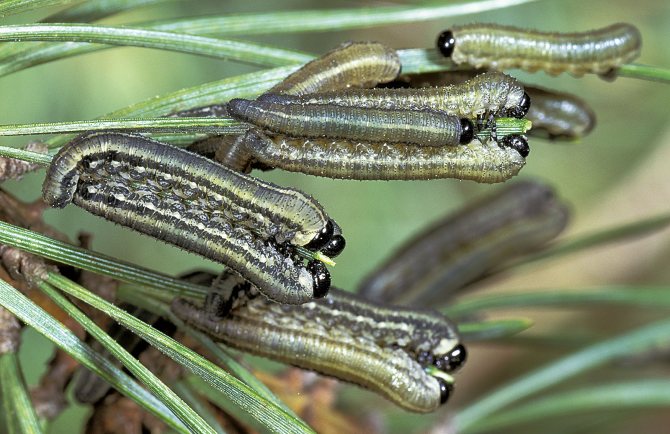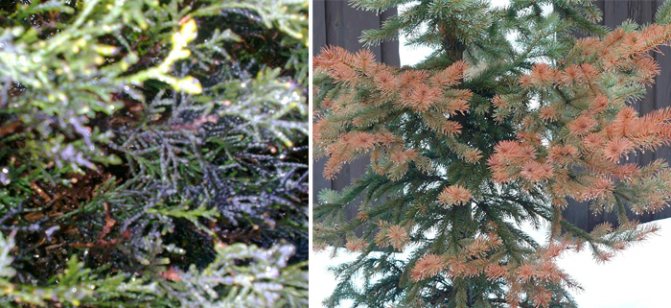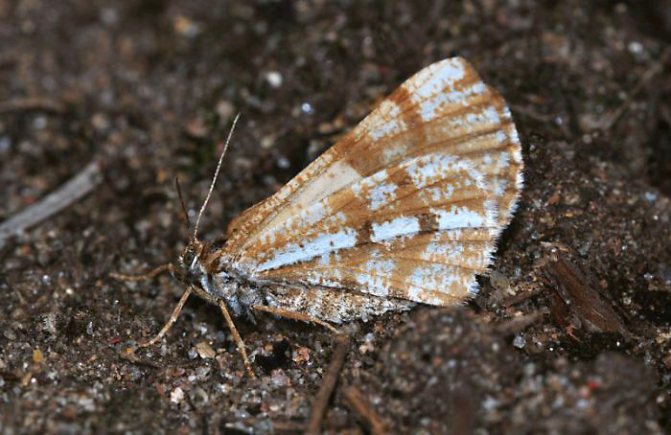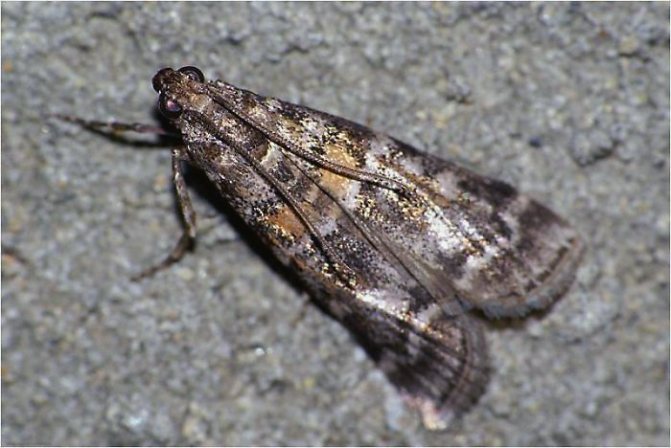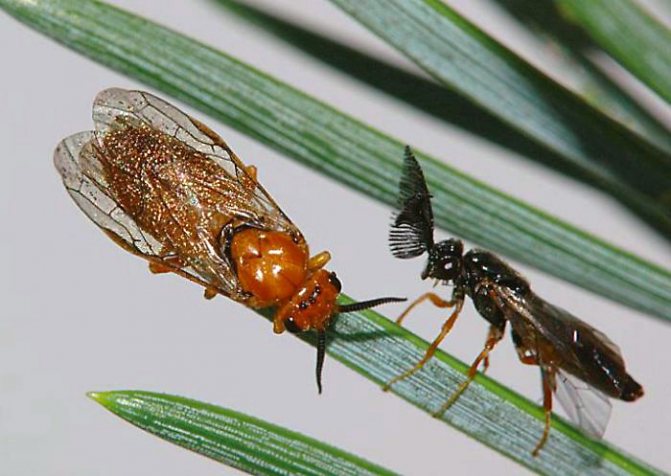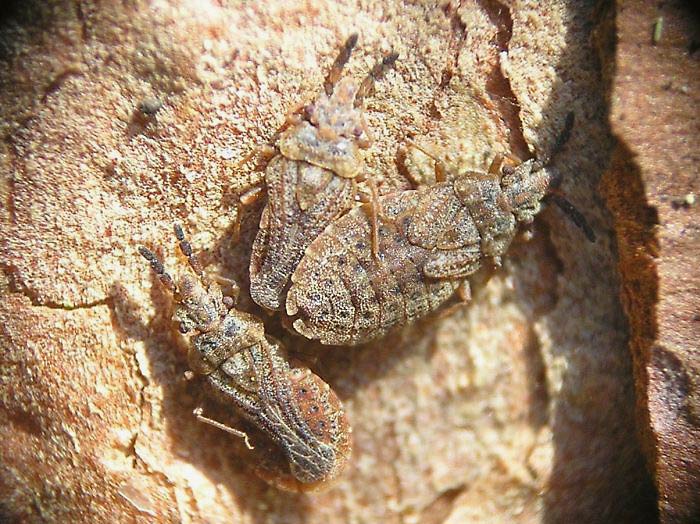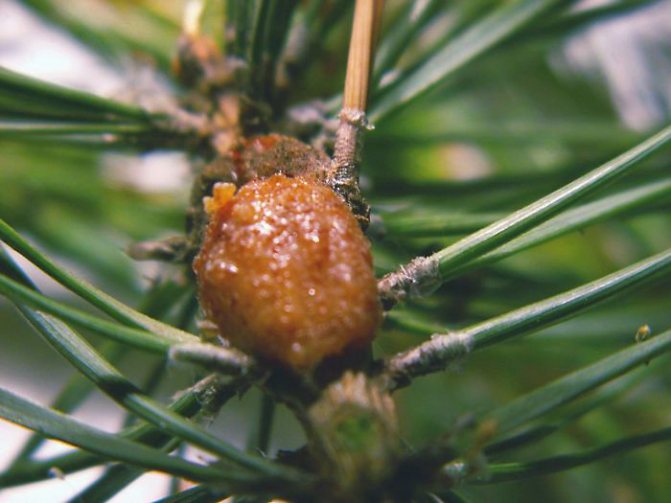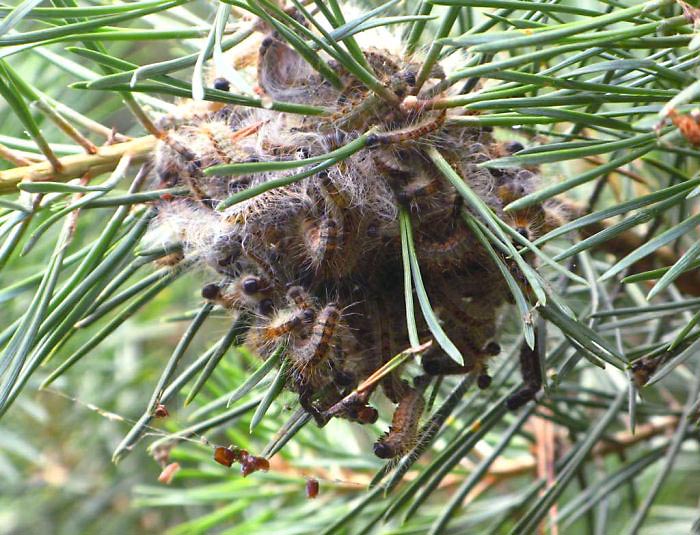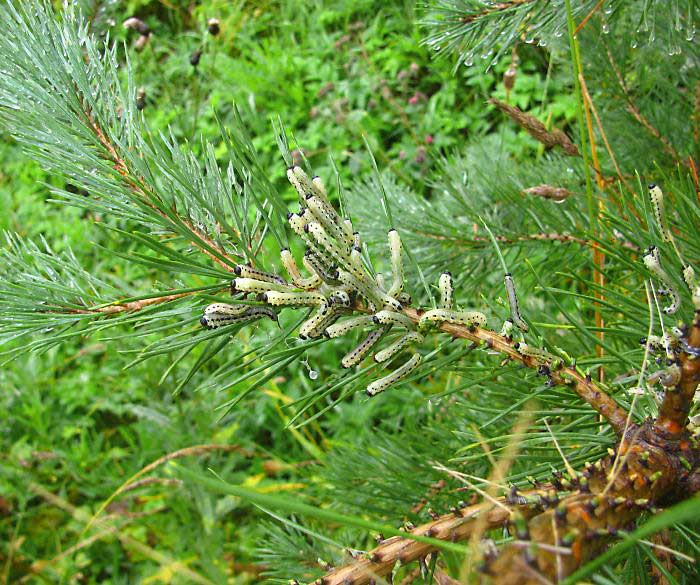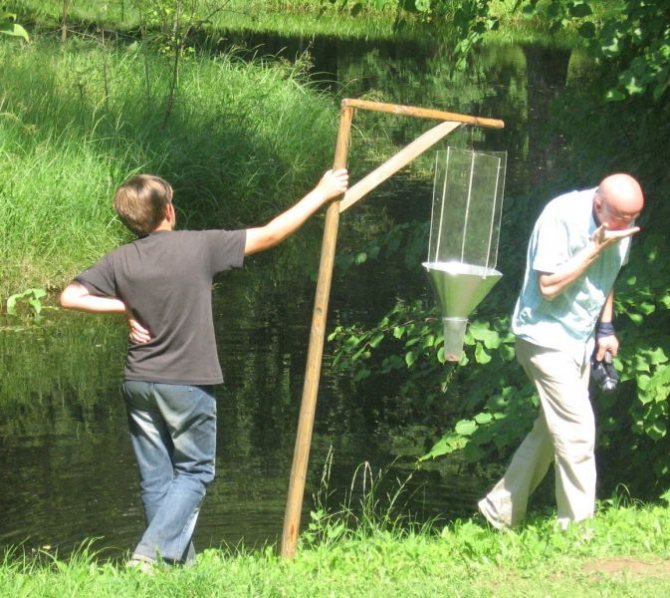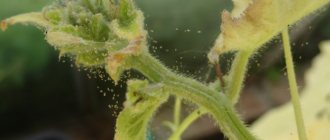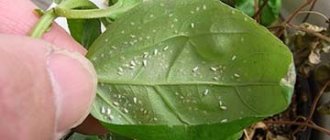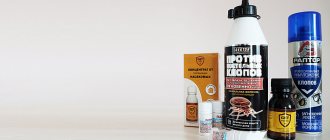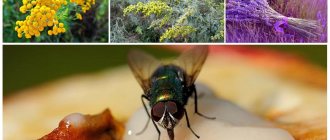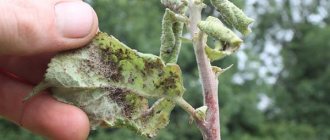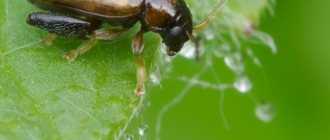The main diseases of ornamental conifers
The tips of the needles begin to turn yellow for a variety of reasons. In the spring, burns occur from the bright sun, and bronze appears. Common infections include fungal infections. Rust more often appears on pine, juniper is affected. From the swelling that occurs on the branches, the spores are transferred to currants and pears. Fusarium, cytosporosis, phomosis are considered dangerous diseases. Thuja suffers from them. Defects appear on the bark, branches. The needles darken and fall off.
Old, unkempt trees are susceptible to diseases. There are breeds of conifers that are resistant to fungal diseases. But they are not immune from attack by caterpillars. There is only one conclusion: they brought evergreen forest curiosities on the site, study ways to combat infections and pests.
How to get rid of and how to treat lichen
On the bark of cedars, which are not sufficiently blown with air and are poorly illuminated by the sun, sooner or later lichens appear. They retain moisture and do not dry well after rain. In winter, the surface under the lichen can crack from freezing of water crystals in it. A good shelter for pathogenic microflora and some pests is also formed here.
Therefore, lichens must be removed from the trunk.
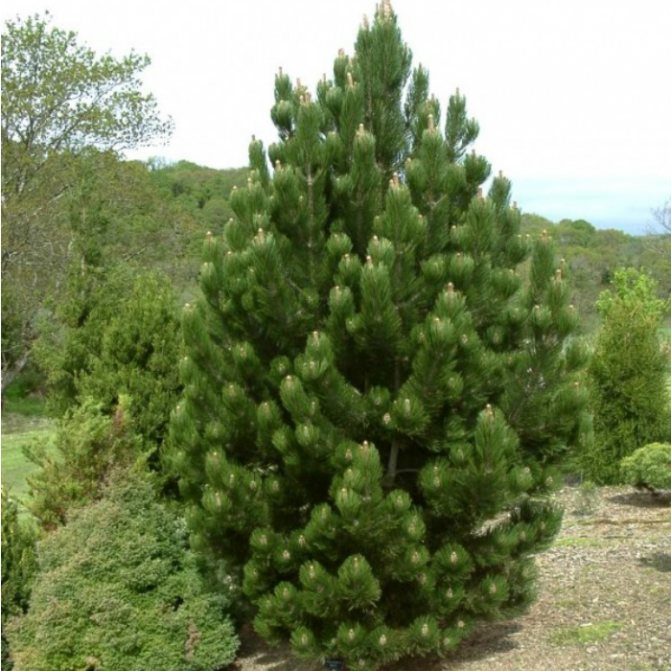
To work, you need a stiff brush: it should be firm enough to help clean the vegetation, but not damage the trunk. The cleaned area must be wiped with iron sulfate (300 g / 10 l of water) - this will prevent the further development of spores that could remain in the cracks.
Non-communicable coniferous diseases and remedial measures
Burn. Solar radiation is especially dangerous for young trees. The snow cover reflects the rays, enhances the evaporation of moisture. Roots in frozen ground cannot compensate for the loss. Sap flow begins when the soil warms up to + 4 ° C, until this temperature the roots sleep. Young conifers planted in the fall can die from burns. I lost a young pine tree, we did not shelter for the winter. I noticed that glare from greenhouses, windows of houses, shiny roofs act like mirrors. If brown or yellowish spots appear on the crown, you need to look for where the bright light comes from.
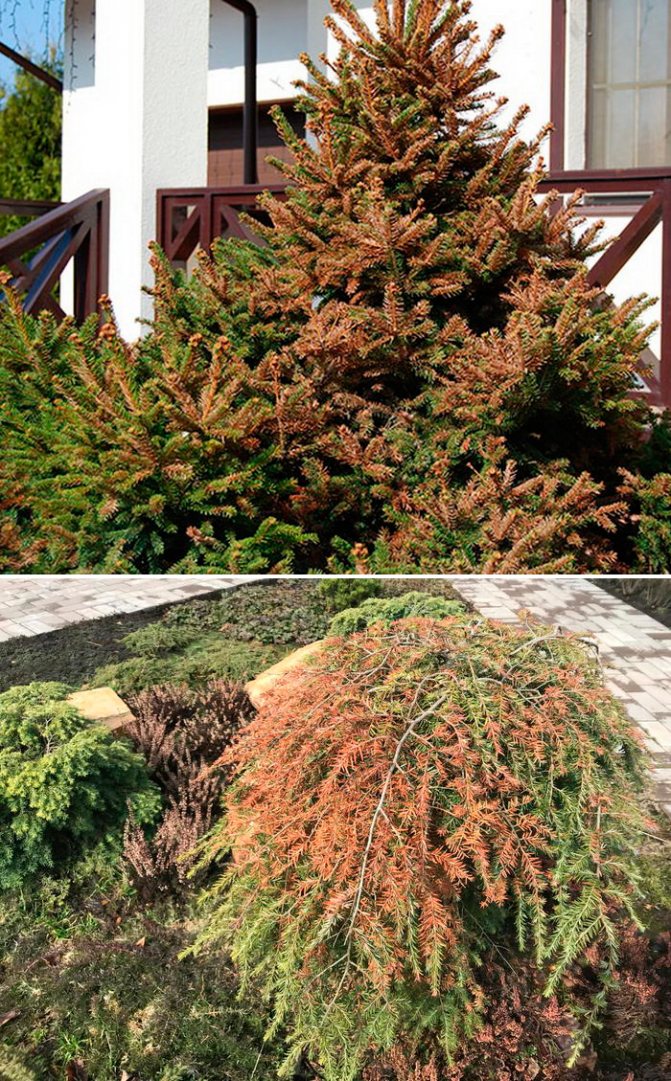

Spring sun protection measures:
- Spraying helps young trees - the branches are abundantly moistened from a spray bottle or garden sprayer.
- You can throw sacking or covering material on small trees in the spring or in the fall. It will protect you from the scorching sun and drying wind.
- Scattering black earth or ash on the snow, they "start" the process of snow melting, the roots begin to absorb moisture.
When planting trees, it is important to maintain the integrity of the root earth coma. When seedlings are purchased in pots, they take root better. Pine trees are more resistant to transplanting, their needles grow after rooting. The most capricious is the forest spruce. She is usually sick for a long time, it is advisable to shade her in the spring during the first three years. From junipers I advise varieties "Skyrocket", "Blualps" (Cossack).
Other causes of yellowing of needles:
- Mechanical injuries to trees occur due to snow load, damage by animals.
- An undeveloped root system is characteristic of weakened seedlings, it is better to immediately choose a worthy planting material.
- With strong return frosts with active melting of snow, the bark cracks, it must be checked, the cracks must be covered with pitch.
- In flooded places, stagnant water provokes the development of root rot, changes the acidity of the soil.
The resistance of conifers to non-infectious lesions is increased by bioactive drugs:
- Kornevin (stimulates the growth of the root system)
- Super humisol is a balanced mixture of trace elements and minerals;
- Zircon is a complex drug;
- Siliplant is a silicon-containing chelated micronutrient fertilizer.
Timely feeding strengthens the immunity of plants well, they are less susceptible to burns, they grow faster in spring.
The main ways to fight
There are several ways to deal with aphids and larvae on a pine tree:
- Chemicals.
- Mechanical removal of insects.
- Folk remedies.
- Biological methods.
Special drugs
Insecticide control methods for aphids on pines:
Aktara
A powerful new generation insecticide. It is a low-hazard substance that does not harm beneficial insects and quickly decomposes in the atmosphere.
Kills the entire colony after the first treatment.
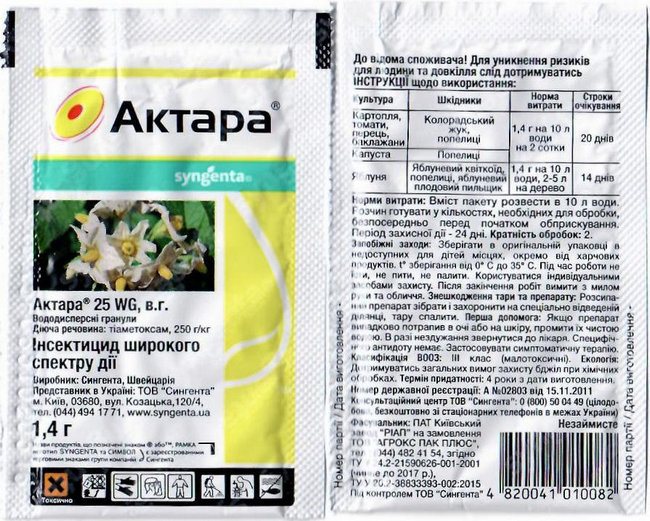

The product contains thiamethoxam. The substance causes damage to the nervous system of aphids, which leads to the death of the insect.
The extract begins to act in two hours, retains its properties in heat and in strong winds. After a day, the rain is also not terrible.
The drug is produced in the form of tablets, powder, concentrated emulsion, granules.
Attention! The drug is effective for 20 - 30 days. Therefore, if re-processing is required, it is advisable to carry out it in a month, not earlier.
Foresight
Effectively fights aphids. A powerful insecticide, belongs to the class of dangerous. The chemical is produced in the form of an emulsion.
The main active ingredient is fenthion.
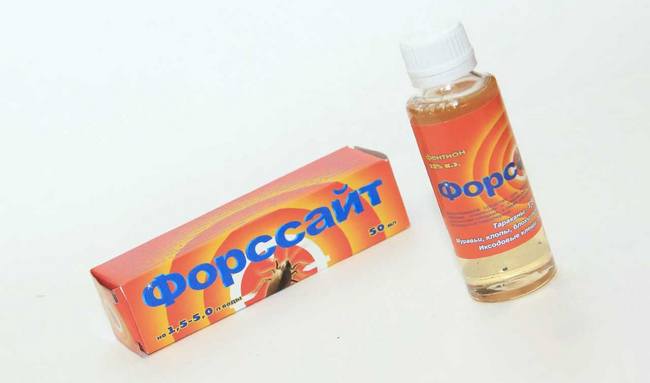

Forsyth is sold in two forms - in a canister, which is expensive, and in a small bottle of 50 ml.
The solution is prepared according to the instructions. Trees are sprayed in the evening in fine calm weather.
Karbofos
The preparation contains malathion. It is produced in the form of a powder, a highly concentrated suspension, a ready-made solution in cans of 5 liters.
Intestinal insecticide. Insects die from contact when the poison is ingested. Often the chemical cannot be used, it is addictive in insects.
The effect of the drug occurs the next day after treatment.


Tanrek
Insecticide of contact-intestinal action. Paralyzes the insect, resulting in death. Mass death of pests occurs already on the fifth day after treatment. The colony is dying out completely.
One treatment per season is enough. Destroys, including aphid larvae. The chemical retains its properties for 30 days. In the soil, the poison lasts up to 190 days. The tool can be used not only for spraying, but also for watering the soil near trees. To increase efficiency, it is recommended that the treatment be carried out in early spring, when the snow has melted and the first insects awaken.
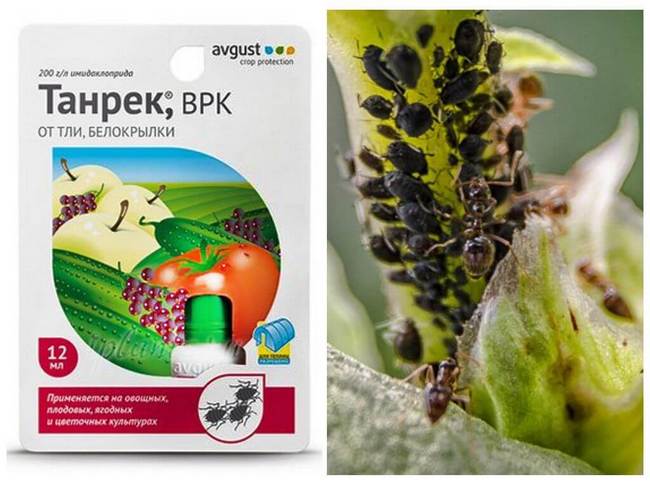

Important! Use personal protective equipment during processing. Be sure to wear a respirator and cover your hair. After the procedure, wash clothes, and wash your face and hands with plenty of water.
Karate
It is a powerful insecticide that gets rid of pests after one treatment. However, it is very harmful to beneficial insects, including bees.
The karate chemical treatment is recommended to be carried out either before the main flowering of plants, or after. This will keep other insects away.


The active ingredient is lambda-cyhalothrin. The drug is produced in ampoules, 2 and 5 milliliters, 5-liter canisters.
The insecticide is diluted as described.Processing is carried out in calm weather, heat is not a hindrance. Insects die within 30 minutes. The complete destruction of the colony occurs within 2-3 hours.
Neoron
Acaricide for protecting plants from pests. The active ingredient is bromopropylate. Temperature has no effect on the effect of the drug. The chemical comes in the form of an emulsion. Does not affect the fruit, is not absorbed into the leaves. Neoron is not dangerous for beneficial insects, including bees. Processing is carried out two to three times per season.
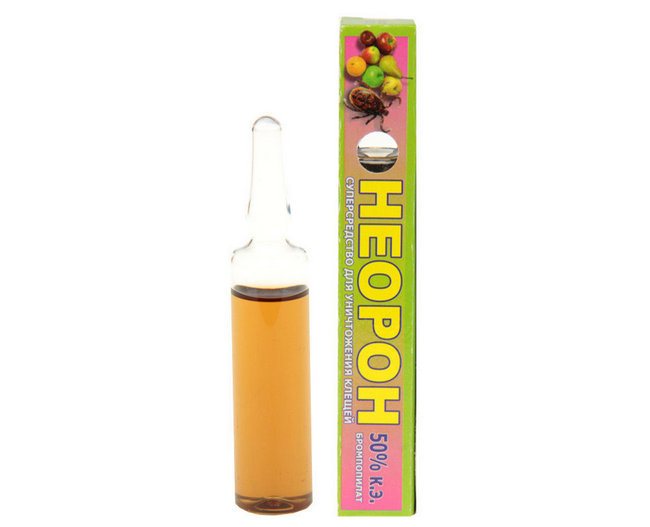

Spark
Spark is a versatile drug that affects any type of aphid. However, the chemical negatively affects bees and other beneficial insects.
The spark has several types:
- Spark Double Effect;
- Spark BIO;
- Iskra-M;
- Spark Gold.
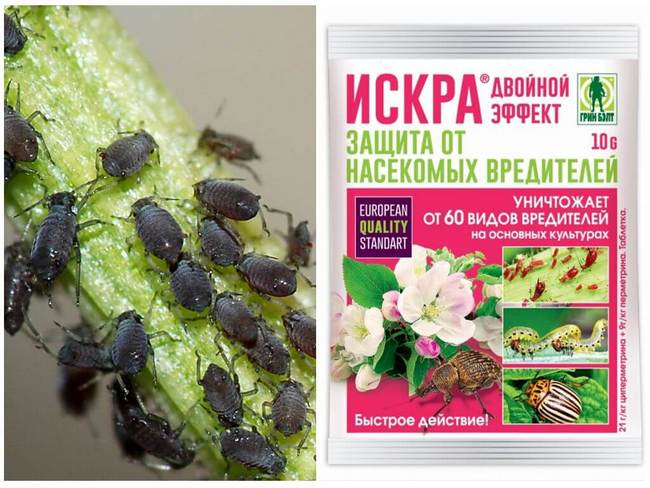

The drug is produced in the form of powder, emulsion, ampoules with poison, compressed tablets. The drug is absorbed into the leaves and the table, completely destroying the colony of parasites already on the second day after treatment. Spraying can be repeated after 30 days, but basically one procedure per season is enough. Trees need to be processed in calm weather. The temperature regime does not affect the effect of the drug.
Akarin
The chemical does not accumulate inside leaves and fruits. It is safe to use it near apiaries, as it does not harm the bees. Acarin is a biological preparation. Affects aphids by complete paralysis, which leads to the death of the insect.
Important! For Akarin to work, you need to treat the area, weed the weeds so that the affected plants are completely open.
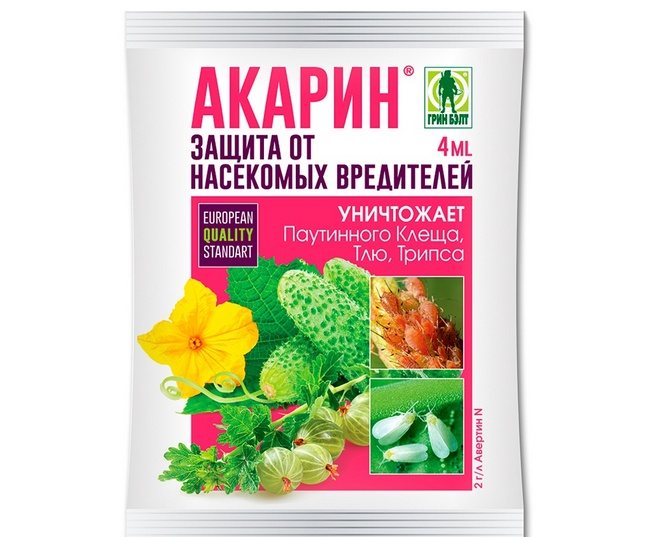

Spark BIO
Natural biological product. Not absorbed into leaves and fruits. Harmless to bees. Trees and soil are cultivated in calm, clear weather. The temperature regime is not important. It is better to start work in early spring. It is better to treat with natural chemicals several times per season.
Their advantage is the absence of harm, the fruits can be eaten the very next day. Disadvantages - weak action. Available in the form of emulsion, powder, tablets.


Arrow
Broad spectrum insecticide. It is used to treat plants from parasites at any time, regardless of the state of the plant - buds, buds, flowering, fruit formation.
The drug belongs to biological, it does not harm beneficial insects, bees, pets and humans.
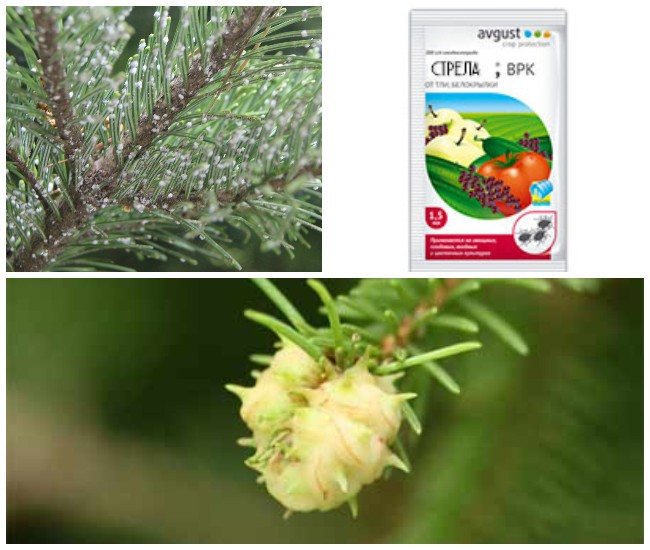

Processing is carried out in early spring and then repeated in the middle of summer. The boom is suitable for shedding soil and spraying.
Infectious diseases of coniferous plants: prevention and treatment
Fungal diseases in all crops are treated in about the same way; in the preventive treatment of fruit and vegetable crops, we must treat the conifers with Bordeaux liquid. If the plant still gets sick, they resort to purchased drugs. It is important to correctly establish the cause of the defeat in order to determine which remedy to purchase.


I'll start with the Schütte winter illness, the fungus develops under the snow, when it is about 0 ° C. Symptoms appear in spring or summer. According to the description, the disease is not similar to other fungal infections, it appears on pins and needles:
- gray-black bloom;
- small dots.
The needles darken or turn yellow, fall off.
Control measures:
- sulfur-lime broth - 3 times over the summer;
- two treatments will be enough with "Abiga-Peak" and "HOM" preparations.
Be sure to shed the soil to a depth of 5 cm.
Rust is similar to fruit tree lesions. Traditional methods of treatment: fungicides and medicinal preparations.
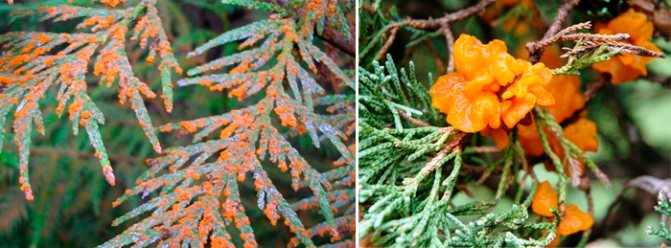

Pine vertune is manifested by the curvature of the growth. Yellow-orange swellings appear. For treatment, you will need Fundazol, two treatments are enough.
Fusarium develops in the soil at the roots of pines, spruces, larch, fir, when it is too damp. The central part of the crown falls off.
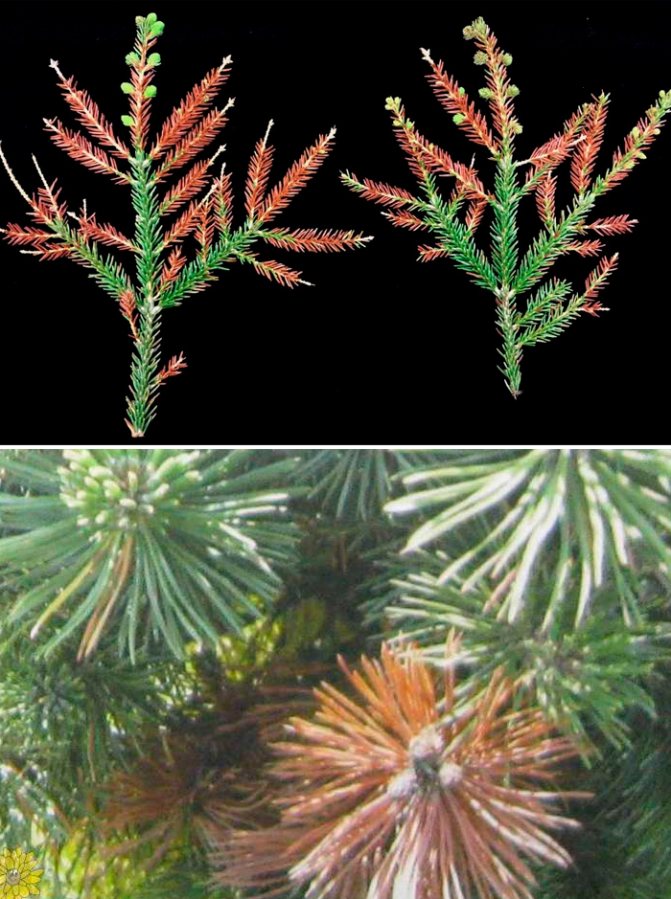

Drainage is carried out, the use of "Fitosporin", "Alirin" will help revive the trees, they will turn green again if the branches do not have time to dry out completely.
Alternaria is terrible for junipers, thujas growing in the shade. Blackish, dark gray spots spread along the needles. The affected branches are removed. For the treatment of conifers, formulations with copper sulfate or an infusion of celandine are used. The fungus must be suppressed until late autumn.


Bacteriosis is characterized by pallor of the needles, it begins to crumble from a light touch. This disease cannot be cured. For prophylaxis, treatment with "Fitosporin" is carried out.
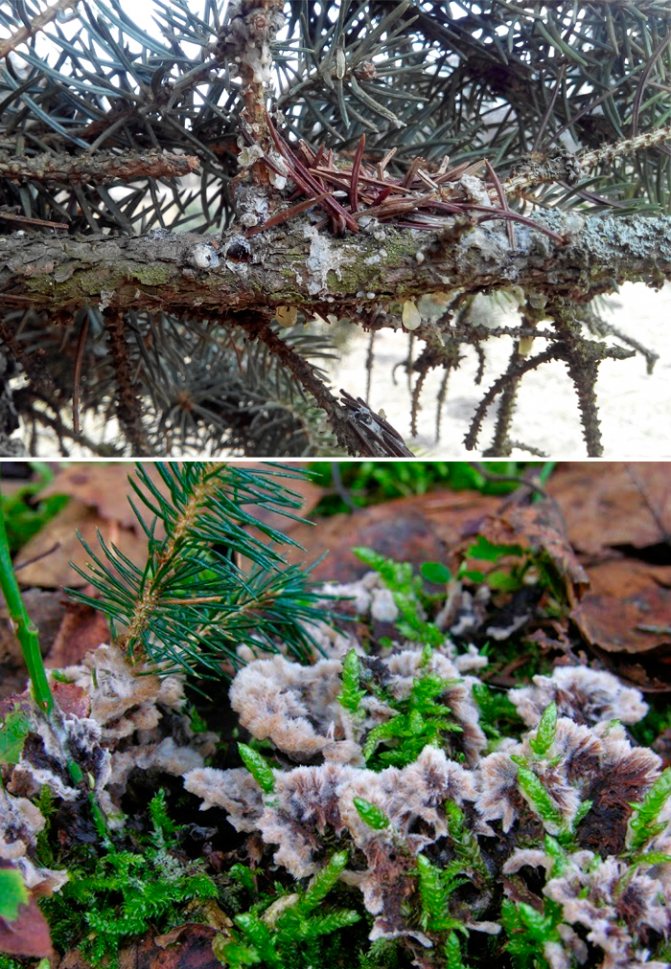

Biotorella cancer is dangerous because it infects wood. When an infection hits, the color of the young bark changes, it becomes brown, then cracks, dies off. Long, elongated ulcers are formed, they are covered with resinous fungal growths.
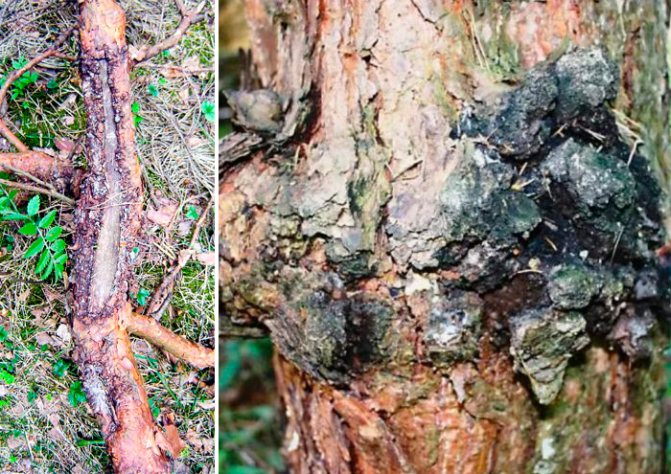

Gradually, the tree dies, the needles turn yellow, crumble. The treatment requires a triple treatment at intervals of 2 weeks. It is important to wet the soil well with preparations.
Pine diseases and their treatment
Diseases in pine trees are of two types:
- infectious;
- non-infectious.
Infectious diseases are caused by viruses, fungi and bacteria. Noncommunicable diseases are not contagious. They appear when the immunity of trees is weakened, due to a lack of nutrients, wet soil, damage to the bark or broken branches of the crown.
Did you know? Pine trees emit phytoncides. They are very much appreciated by doctors as a means of combating diseases of the lungs and bronchi. In combination with oxygen saturated with sea salts, this ingredient is considered indispensable in the treatment of bronchitis, allergies, tuberculosis and asthma.
If wounds, small black warts (necrosis) or ulcers appear on the trunk of the plant, the needles have lost their density or changed color, and the branches began to dry out or deform, then the tree is ill. But such manifestations cannot be triggered, because they quickly spread throughout the plant and weaken it. Pines have a number of diseases, the signs of which should be looked at more closely, as well as remedies for them.
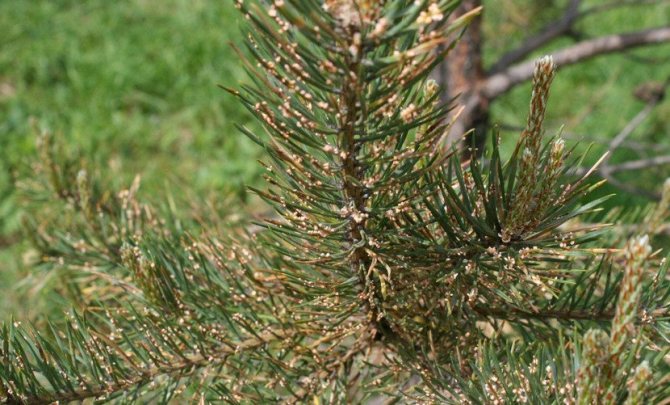

The defeat of pine needles is especially unsafe for young pines, since they do not have adult shoots. If the needles of a plant are older than 2-3 years, then the tree has a chance of getting better.
Rust
Rust is caused by fungi that parasitize the living tissues of the tree. They are unable to exist in a dead body. Fungi "suck" all nutrients from the pine plant and infect the nearby plant when their previous host dies. This disease manifests itself in the form of spores of a brown or orange (rusty) hue on the affected area of the plant. They multiply rapidly and in a short period of 1 to 2 months can take over the entire tree. In addition, the spores of these fungi travel long distances through the air and do not lose their viability, even when crossing an area of 10 thousand km.
You may be interested to know how many years Scots pine lives.
There are 3 types of rust:
- Pine needles rust. Caused by the fungus - Coleosporium, appears as yellow or orange blisters ranging in size from 1 to 3 mm and a width of 1 to 2 mm. During the summer period, spores ripen in these formations, which, having matured, spread along the tree and intermediate hosts (weed grass around the trunk). There, these fungi go through the remaining maturation phases and in the spring move again to the pine needles. The fight against coniferous rust consists in removing weeds around the tree and spraying the needles with 1% Bordeaux mixture.
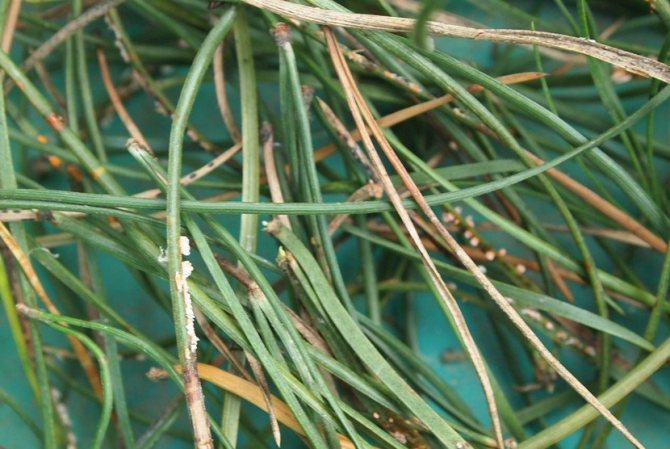

- Rust on the shoots. It appears due to the fungus - Melampsora pinitorqua, it can be identified in late spring or June by the yellow swellings on young growth. Then these "pillows" darken, acquiring a reddish color, and at the end of August they completely turn black.This type of fungus hibernates on fallen leaves, and in the spring it affects a tree, bends its trunk, and can even lead to the death of the top of the plant. In rare cases, the pine dies. Fight this disease by removing fallen leaves away from the tree, isolating already affected plants and treating pine plants with 1–0.5% Bordeaux mixture at the end of spring.
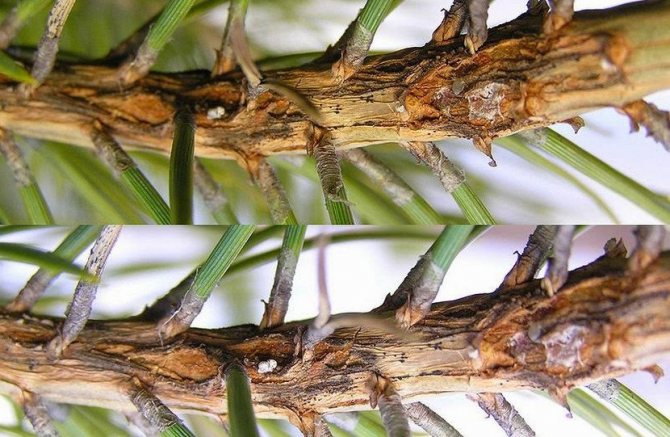

- Blister rust. The causative agent of the fungus - Cronartium, passes to representatives of pine from currants or gooseberries. It affects young shoots in the autumn. After 2-3 years, in the months of April and May, it manifests itself in the form of bubbles of a yellow or orange hue filled with spores. These formations cause thickening, and over time, wounds on the pine branches. Bubble rust is fought by removing the branches affected by it and isolating pine and currant plants from each other. Planting any other crops between currants and pine also helps.
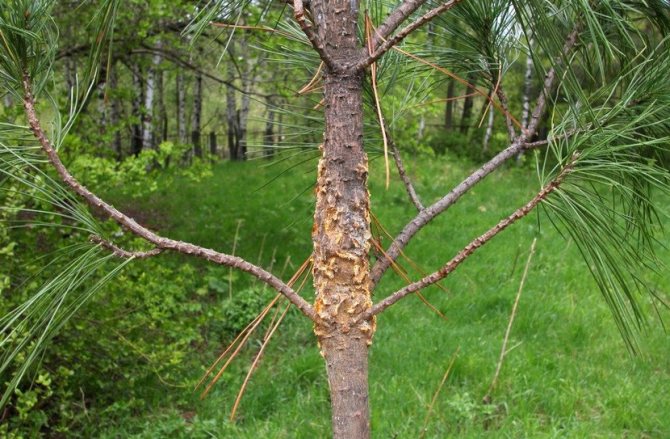

Vertun
Such a disease as vertun is easy to define, with it the shoots on the tree are bent, taking the shape of the English letter "S". Damaged processes dry up and die off over time. This disease is caused by a mushroom - etsidium. It affects the plant in May-June, looks like a swelling of yellow shade 1-2 cm in length and 1-3 mm in width.
Important! A natural barrier created from some other tree culture, such as birch, can be drawn between pine poplars and aspens.
Ripening by the end of summer, the nearby trees, aspens or poplars, burst and fall asleep with orange spores. The fungus hibernates on the fallen leaves of these plants, acquiring a black color, and the next year, in the spring, it enters its second stage, in the form of a silvery bloom, and finally affects the pine tree. Young pine stands are especially susceptible to this disease.


It is necessary to treat the vertun by isolating young pine trees from poplar and aspen, and in the spring treating the trunk and shoots with 1% Bordeaux liquid, 0.8% zineb or 1% polycarbacin.
Powdery mildew
If on a pine plant there are drops in the form of a raid, similar to rain residues, this is a sign that the plant is affected by powdery mildew. The plaque is actually spores of Erysiphales, a parasitic fungus. It prevents the plant from developing normally by blocking access to sunlight. Because of this, the needles darken and fall off. Pine affected by powdery mildew becomes more susceptible to temperature changes, weakens and loses its "fluffy" appearance.
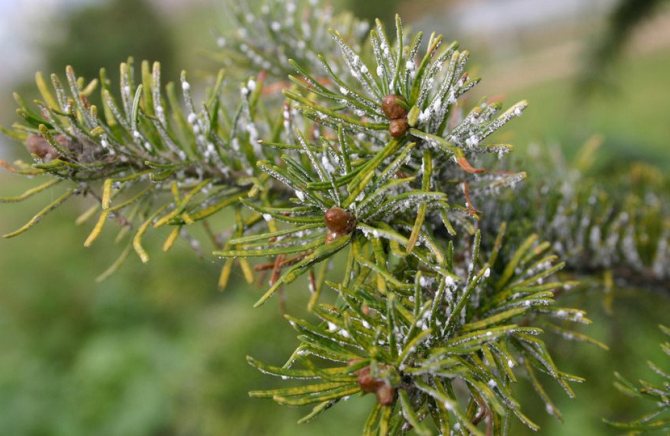

Treatment for this disease consists in spraying with a foundationol or colloidal sulfur. Processing should be carried out 3 to 5 times per season.
Fusarium
Fusarium is due to the fungus - Fusarium. As a rule, plants with weak immunity, located in poorly lit, boggy or densely planted places, are susceptible to this disease. The crown of a pine prone to fusarium thins, acquiring a red or red hue. The fungus clogs the vessels and roots of the plant, disrupting its normal nutrition with useful substances. Such a violation soon leads to the death of the tree. Young animals are most susceptible to this disease.
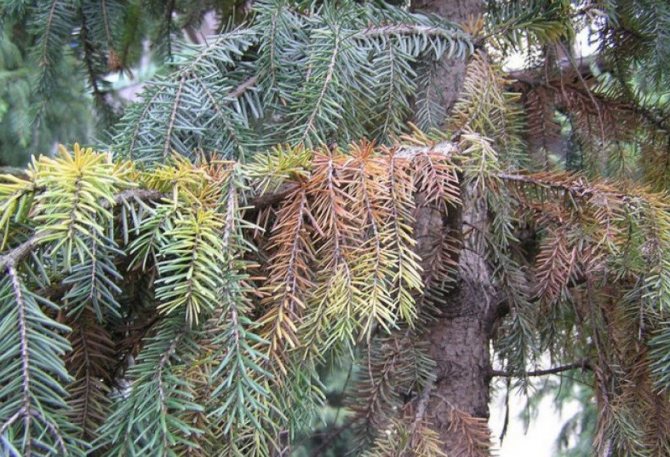

It is difficult to cure fusarium disease; selection of high-quality planting material and strict planting care serve as prevention from it. You can also treat young, freshly planted trees with fungicides, but if the disease has affected the plant, then the best solution would be to destroy the affected material in order to stop the spread of the fungus.
Schütte
If the needles are covered with black spots, turn gray or acquire a brown tint, it means that the shute was struck by the landing. This disease appears due to the fungus - Colletotrichum gloeosporiordes. If you start it, the needles can crumble almost completely, and the tree can weaken and even die. This ailment should be treated in the autumn, before the snow falls, the plant is treated with colloidal sulfur or a fungicidal solution.
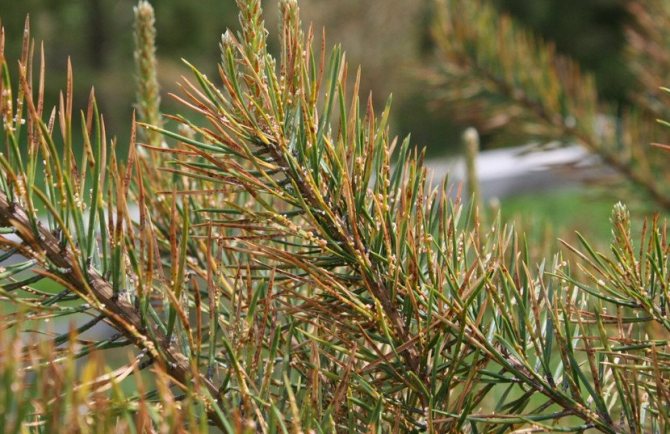

Scleroderriosis
This disease is caused by the fungus - Scleroderris lagerbergii. It attacks young pine trees up to 3 years old. The affected plant loses needles, which first hang down with needles and then crumble. With advanced forms of scleroderriosis, the needles acquire a brick shade. This means that the fungus has penetrated the tissues of the plant and its trunk.


Saplings infected with this disease die quickly, mature trees can last for several years, but without treatment they also die. Scleroderriosis is treated with fungicidal agents, copper sulfate or Bordeaux mixture. The affected areas of the tree are removed.
Pine cancer
Cancer diseases in pine trees occur due to the defeat of their pathogens.
Important! Cancer cannot be completely cured. The process can be suspended or slowed down, but the tree will still not live. If only one pine out of many is affected on the site, it is best to remove it so as not to infect healthy plants.
There are 4 types:
- Resin cancer or silverfish, because of it, the bark peels off and dies off. The tree will live, but it loses its healthy appearance, turning into a dwarf tree, lags behind in growth and splendor of the crown from healthy plants. It is incurable, but you can stop the process if you treat the site of infection with one of the biocidal antiseptic drugs.
- Rusty or bladder cancer easily identified by yellow spots on the needles. After a year, almost the entire tree - bark and branches become orange. Soon the affected tree dies, gradually losing the affected branches.
- Ulcerative cancer - as the name implies, forms wounds or ulcers on the trunk and branches. They are covered in resin and can be as large as half a tree. This type of cancer is especially common in plantings with wet or swampy soil. They fight it by stripping the trunk to healthy tissues, and the affected area is also treated with fumigation agents.
- Shoot cancer - with him, the needles turn red, tilt downward, and eventually fall off. Leads to the death of shoots at the top. On the bark of a tree, black formations appear in the form of warts. You can try to cure this disease by treating the affected areas with fungicides.
Video: cancer of pine trunks and branches
Necrosis
One of the first symptoms of necrosis is the acquisition of a red tint by needles and bark. Then black bumps appear on the trunk. This leads to decay and death of the affected tissue. Soon the tree begins to lose its needles, then branches and bark. Young pines up to 15 years old are especially susceptible to this disease. Disease of necrosis leads to the death of the plant.
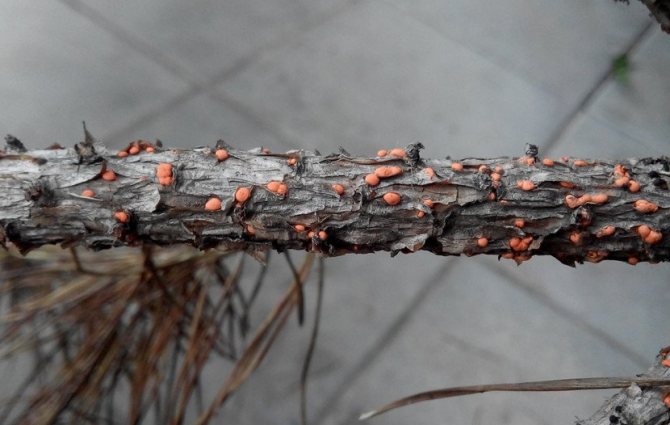

Ephedra pests prevention and control methods
It is advisable to help the trees in early spring, as soon as the snow melts, during the day the air temperature will rise to +6 ° C. If processing is carried out in the fall, then you cannot get rid of pests and diseases, insects prepare for hibernation, climb into secluded corners. I dilute the preparations according to the instructions; when working, I must use protective equipment.
Now about the insects that you have to fight with, and how to do the treatment:
Fir, cedar and common pine, spruce, larch are sometimes infected with rapidly multiplying hermes, it is also called pine aphid. The definition of the pest is simplified by the appearance of a white bloom.
Sucking insects with transparent wings grow up to 2.5 mm, their color is green, dark brown, black and gray. Hermes suck juices from young shoots with small antennae.
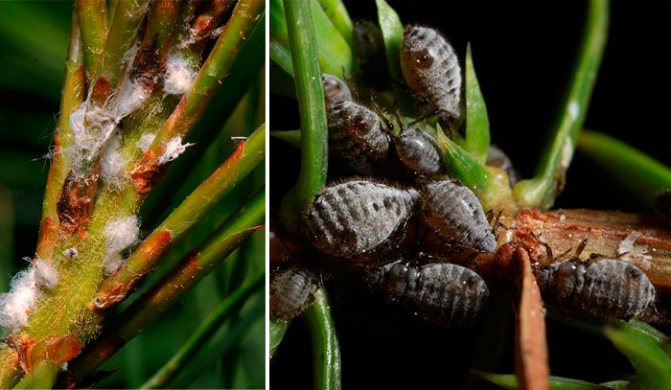

The best remedy for Hermes is the universal remedy Pinocid against pests, the instructions indicate the dosage of the remedy for different types of insects.
Insects affecting needles, shoots and roots


This group includes a large number of insects. They feed on bark, roots, needles, young and last year's shoots.If these pests appear in large numbers, they can even cause the death of the plant. Many of this group of pests are beetles.
The most common among them:
- gray-haired pine weevil - adult beetles (up to 11 mm in length) feed on bark and needles, the larvae damage the roots;
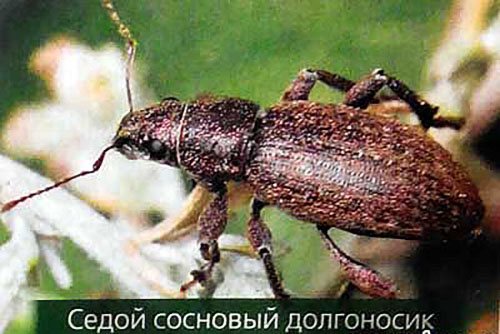

- point resin - small beetles (up to 7 mm) are dangerous for bark and needles, and the larvae gnaw through the passages in the tree;
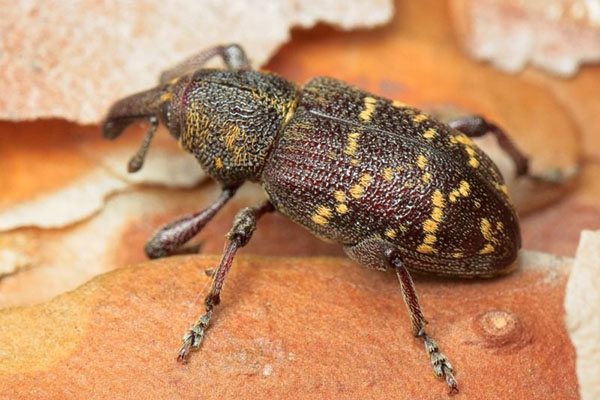

- large pine weevil - prefers young trees.
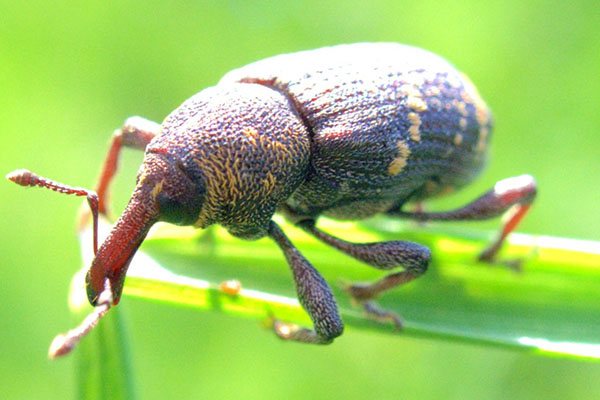

Some pine pests are butterflies of the Shootweed family. This group includes summer shoots, resinous, budding and wintering ones. For trees, the larvae of these insects are dangerous, which may differ: in wintering victorious it is a black caterpillar, in others it can be brown, gray, orange.
When choosing how to spray pine from caterpillars, you should pay attention to the composition of the drug and instructions for use. For preventive treatments, it is better to use complex products that contain active substances against many insects at the same time.
Pine pests are insects that damage the bark, shoots, needles or roots of trees in the course of their life. They can belong to different groups, but most often the larval stages bring harm. The fight against caterpillars should be annual. It is enough to use insecticides according to the instructions, and pests will not appear on the site.
Insects that harm the pine tree
You need to know which insects harm the tree the most. Consider what pests are dangerous for needles, bark and roots.
For needles
Pine silkworm is an insidious tree pest, especially harmful to mountain and Crimean pine.
Females can lay up to two hundred eggs. The eggs are large, fifteen or twenty days later a caterpillar appears.
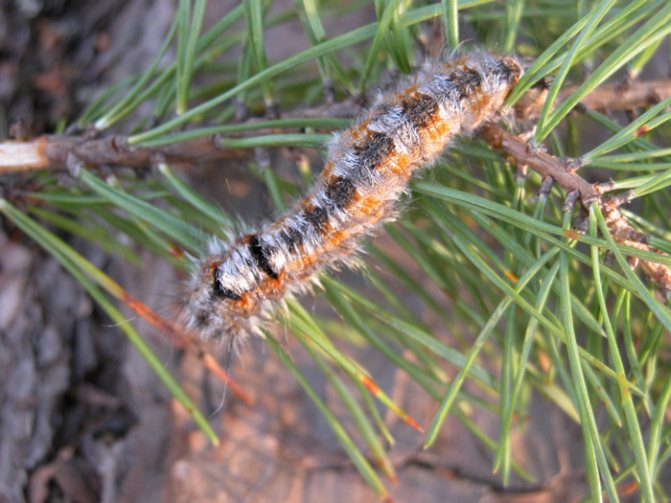

They immediately begin to actively feed, they can even eat the whole plant. One caterpillar eats about 700 needles.
The red pine sawfly prefers to eat pine needles, mountain pine and Crimean pine.
It very much damages the tree, because of which it loses its appearance, the growth decreases and bark beetles settle on it in the future. When the active flowering of the pine begins, larvae appear on the tree.
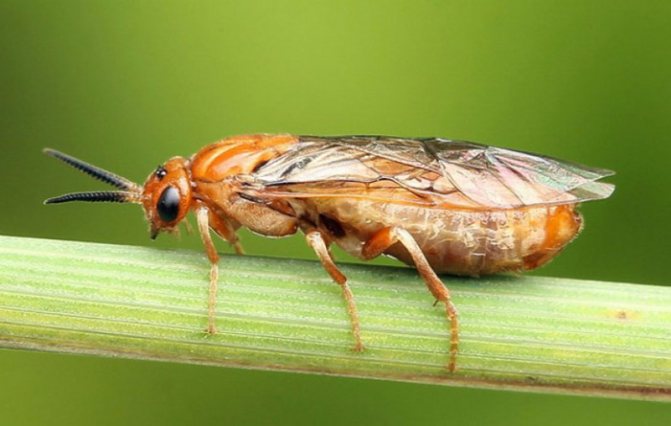

Usually they live in joint groups, for example, twenty or thirty pieces, usually eat needles of past years. They are able to leave only one stump from the branches.
The common pine sawfly is very dangerous for the tree, eats abundantly of needles, which has a very negative effect on the pine. They start flying from mid-spring. The female is able to lay up to 150 eggs among the needles.
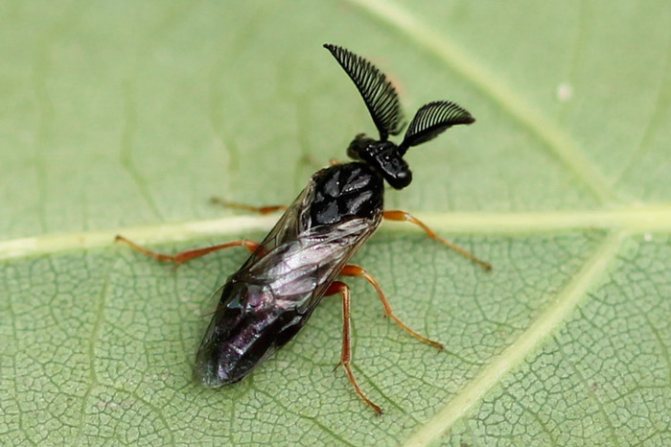

In the spring he likes to lay older needles, and in the summer he chooses the branches of this year. Small larvae gnaw the needles, and those who are older - eat all the needles whole.
The red-headed weaver sawfly lives on the common pine, sometimes it can be seen on the Weymouth.
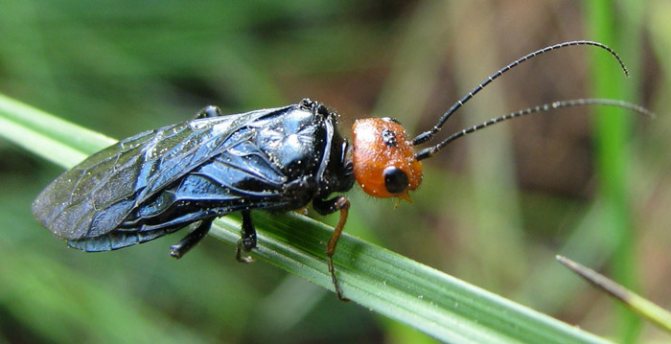

They start flying in the middle of spring. Pine hawk moth lives on Scots and Crimean pines.
The female is capable of laying up to two hundred eggs. Caterpillars are formed in summer, development takes about a month, then they begin to actively eat the tree.
The pine scoop is very harmful to the common pine, but it can also feed on other specimens of the tree.


Females lay about ten eggs, and sometimes more. This mainly occurs from the bottom of the pine needles. Caterpillars of older years eat needles whole.
The pine moth prefers to eat the needles on top. Subsequently, resin appears on the needles, the needles begin to turn yellow and then fall off.
Bark, trunk and roots
The pine birch bug is able to suck out pine tissue, causing the tree to weaken. In addition, there is a specific smell from them.


The peak of breeding and eating occurs during the spring. The trunk begins to turn yellow, the bark begins to crack and resin flows.
Brown pine aphids prefer tree sap.


In the spring they live on young shoots, and in the summer they move to large branches, it is preferable for them to continue their genus there.
The wintering shoot in summer begins to gnaw the bud, where a cobweb is formed, capable of covering the caterpillars.
The summer shoot prefers to gnaw the May shoot with needles.


Because of this, they become crooked and dry. Caterpillars also harm the shoot tops. The bud shoot starts flying in May and continues until early June.
Why the pine sawfly is dangerous
Let's see how dangerous the pine sawfly is. And it is dangerous because it causes great damage to conifers. The first outbreak of damage to pines occurs in late April - early May. The damage to the coniferous cover during this period is insignificant. By mid-May, the damage intensifies. Caterpillars eat pine needles, causing serious damage to dwarf and young specimens, often leading to death. Older conifers get sick, but they cope with the consequences of the pest. An adult pine can survive up to four active sawfly outbreaks.
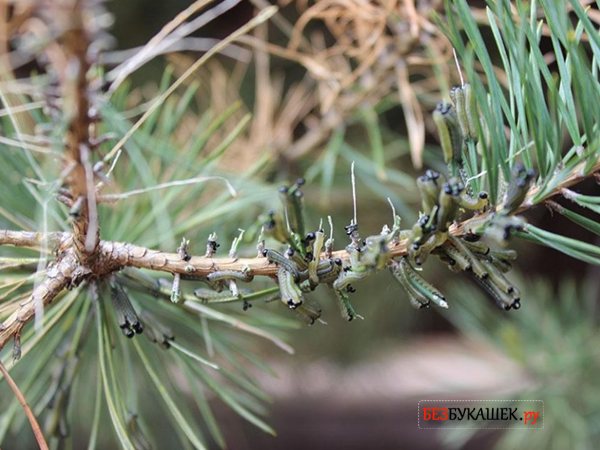

If you do not take any measures to destroy the pest, adult pines will also die in the fifth year.
In the process of growth, caterpillars pupate. Then, adult insects are born from the cocoons, which lay new sawfly eggs.
A favorable environment allows the pest to reproduce two generations of offspring in one summer.
This requires:
- air temperature fluctuating in the range of 25-30 degrees;
- the minimum period of stable temperature is 20 days;
- lack of rain during the development of pests.


Prolonged torrential rains cause infection of insects at different stages of growth, contribute to the immersion of the sawfly into hibernation and can lead to its complete destruction.
Pests of coniferous trees overwinter in the root zone of coniferous trees, where they hide in the grass and fallen pine needles.
The best pine pest remedies
Conifers are especially unpretentious in care, but they are very susceptible to pest attacks. Therefore, preventive measures should be taken as often as possible.
To avoid massive reproduction of pests, you must constantly monitor the first signs of their appearance. Preventive measures are best started in early April.
Chemicals
Plants can be sprayed with biological products Lepidocid, Lepidobacticide, Bitoxibacillin, as well as chemical insecticides, for example, Actellik, Confidor.
You can treat pine from bark beetle with Arborjet. This drug is naturally injected into the tree trunk under pressure.


These funds are located throughout the tree, along with the sap and all the nutrients, which undoubtedly protects the pine from the inside.
It is also possible to process the tree in the spring, Decis, Karate, Aktara, Engio are considered effective drugs against pests.
Traditional methods
There are also many ways to combat pests with folk remedies:
- Dissolve potassium soap in one liter of warm water. Rub the tree trunks with the resulting solution.
- You need to take 400 grams of citrus fruit peel, then pour one liter of boiled water. Allow the water to brew for three days. After that, spray the tree with a spray bottle.
- Soak 200 grams of tobacco in five liters of cold water. Then it is necessary to leave to infuse for a day, then strain. Then add 100 grams of laundry soap to this solution. With this tool, it is advisable to process pine and Christmas trees several times with a frequency of every 3 days.
The appearance of an adult
The appearance of adult insects of both types of sawflies is almost identical. Differences are only between the female and the male.
The female has a light yellow, sometimes reddish color of the body. Black spots are located around the entire perimeter.The size is small, the length does not exceed 1 centimeter.
The appearance of the female sawfly is very similar to the pupa of this insect. It is in a cocoon of the same yellow color, and the length is no more than one centimeter.
The pink-pink pink bloom causes a large number of very small dots on the top of the rose leaves that protrude as a small yellow-white leaf. This damage first appears around the nerve, later it covers almost the entire leaf area. For large-flowered roses, shoots with stronger leaves tend to restrict their growth to length. The intensity of the damage depends on the type and variety of roses. Most affected are sunflowers, especially those growing in dry, sunny habitats, protected from air currents.
Males are colored black, except for the paws (reddish tint). The mustache is shaped like a wave crest.
Prevention of the appearance of pests on pines
In order to prevent the fight against various pests, it is necessary to examine the tree in a detailed way, or simply periodically and by inspections.
The preventive methods include organizational, agrotechnical and forestry measures.
You will also need to create a surveillance service that will monitor the appearance of pests and immediately take measures to prevent their spread.
The most favorable time for pest control is the period when larval caterpillars appear. At this time, you can make chemical treatment or try to collect the caterpillars by hand and burn.
This will help prevent further reproduction and growth. After carrying out all these activities, the tree needs special care. The pine must be fed with fertilizer.
Conclusion
If the pest is detected in time and the correct therapeutic measures are taken, then the tree will be reliably protected.
Video: Spring treatment of ephedra from diseases and pests
Conifers are most often used in landscape compositions for landscaping, therefore, the description and knowledge of their diseases is a very topical issue. Young and weakened trees are affected faster than others, and the coniferous litter hides thousands of microbes, parasites and bugs - it serves as a good breeding ground for them. What are the pests of pine, their types - I'll tell you about this.
Prophylaxis
Remember that any disease of the common pine, be it a pest infestation or a fungal disease, is much easier to prevent than to treat the tree and hire a specialist.
Adhere to the following recommendations to maintain strong immunity and a beautiful appearance for your adult pine or young seedlings.
- The soil. The key to the health of any tree and plant is a properly selected place with soil rich in nutrients and moisture. Do not forget to constantly monitor the moisture level of the soil in which the pine tree grows, and also regularly supply it with mineral fertilizers.
- Sunlight. Most of the fungal pathogens develop precisely in darkened and humid areas, and therefore try to plant your pine trees in places with good natural light.
- Ventilation. Do not forget about the constant access of fresh air to the pine - for this, preventive pruning and thinning should be carried out every spring.
- Saplings and seeds. Conscientiously approach the selection of seedlings and seeds for planting - they must be of high quality and healthy. To do this, it is better to buy them in special forest nurseries.
- Fungicide treatment. Do not neglect the preventive treatment of your pines with standard fungicidal agents: Bordeaux mixture, copper sulfate. These funds, provided they are used no more than 1 time a year, will not bring any harm to the plant, but will only strengthen its immunity and prevent the appearance of pests and the development of diseases.The products necessary for the processing of conifers can be bought at every gardening store at affordable prices.
- Loosening. Remember to do regular weeding around the trunk of your pine tree, especially when it comes to young plants. Often, weeds are carriers of fungal spores or serve as nests for pests.
- Pruning. At the beginning of the spring season, carry out preventive pruning of your tree - it will remove dried and diseased pine branches, diseased needles. In addition, pruning will thin out the crown and provide good ventilation.
For information on what pine pests are and how to deal with them, see the next video.
This will help prevent further reproduction and growth. After carrying out all these activities, the tree needs special care. The pine must be fed with fertilizer.
Conclusion
If the pest is detected in time and the correct medical measures are taken, the tree will be reliably protected.
Pine diseases
Diseases are divided into infectious and non-infectious. Scots pine diseases and their treatment:
| Real shute |
Appearance
- brown spots appear on the needles;
- in the fall, yellow spots appear on the affected leaves;
- on already fallen needles, a large number of black fruit bodies are formed
The reasons
- fungal disease;
- lack of light;
- unventilated areas when planting thickens
Treatment methods
- spray with systemic fungicides;
- remove the affected crown;
- to clear the area of fallen needles
Prevention measures
- selection of shute-resistant varieties;
- prevent thickening of the landings;
- thinning the crown;
- crown treatment in spring and autumn of young plants with Bordeaux liquid, HOM or lime-sulfur solution
Appearance
- the needles acquire a reddish-brown or yellow color and fall off;
- on the fallen needles, fruit bodies are formed in the form of black stripes or spots
The reasons
- fungal disease;
- lack of light;
- unventilated areas when planting thickens
Treatment methods
- spray with systemic fungicides;
- remove the affected crown;
- to clear the area of fallen needles
Prevention measures
- selection of shute-resistant varieties;
- prevent thickening of the landings;
- thinning the crown;
- crown treatment in spring and autumn of young plants with Bordeaux liquid, HOM or lime-sulfur solution
Appearance
- the needles are red-red, light gray;
- the needles crumble, but do not fall off
The reasons
- fungal disease;
- lack of light;
- unventilated areas when planting thickens;
- snow cover of the territory
Treatment methods
- spray with systemic fungicides;
- remove the affected crown;
- to clear the area of fallen needles
Prevention measures
- selection of shute-resistant varieties;
- prevent thickening of the landings;
- thinning the crown;
- crown treatment in spring and autumn of young plants with Bordeaux liquid, HOM or lime-sulfur solution
Appearance
- after the snow melts, brown dead needles are noticeable, on which a dark gray cobweb bloom is visible
The reasons
- fungal disease;
- lack of light;
- unventilated areas when planting thickens;
- snowiness of the territory
- high humidity
The reasons
- spray with systemic fungicides;
- remove the affected crown;
- to clear the area of fallen needles
Treatment methods
- selection of shute-resistant varieties;
- prevent thickening of the landings;
- crown thinning
Prevention measures
- crown treatment in spring and autumn of young plants with Bordeaux liquid, HOM or lime-sulfur solution
Appearance
- branches bend, the top of the shoot dies;
- small yellow spores of the fungus are formed on the needles, and by autumn black spores of the fungus - teliopustules;
- the bark is affected - increased formation of resin
The reasons
- fungal disease;
- pine is an intermediate host of the fungus;
- aspen is the final owner
Treatment methods
- remove affected plant parts;
- make microfertilizers and immunostimulants
Prevention measures
- avoid plantings of aspen and bird cherry;
- remove plant residues
Appearance
- the bark on the trunk and thick branches cracks;
- dirty yellow bubbles emerge from cracks;
- they contain controversy
Causes and signs of defeat
Unfortunately, gardeners do not always have the opportunity to follow absolutely all the rules for growing ornamental plants on their territory. Therefore, the causes of a certain disease or the appearance of a pest can be very different.
- High or low humidity level. Also, this can include a high level of groundwater, excess or lack of water.
- Insufficient soil disinfection before planting pine.
- Supply of shoots with low-quality fertilizers.
- Lack of preventive spring pruning of dead needles and branches.
- Lack of natural sunlight.
- Poor ventilation of internal branches due to too dense needles.
- Poorly chosen landing site - usually too low or exposed to strong winds.
- Errors in the purchase, receipt and planting of seedlings, damage to the root system.
- Planting not far from already infected trees.
- Insufficiently high level of soil acidity.
If we are talking about signs of damage and disease, then they can be different depending on the disease and the pest. The most basic:
- changes in the appearance of needles and branches - yellowing (for example, with rust) or darkening (necrosis);
- falling of needles or branches;
- the presence of white, black or yellow bloom or bubbles on the branches of the tree;
- cobweb or white dots on pine needles;
- the lag of the bark from the tree trunk;
- the presence of holes and "paths" in the trunk of a tree or on branches;
- the presence of insect colonies in needles or between tree branches;
- gradual dying off of the root system or top of the tree;
- the appearance of cancerous ulcers on the bark of a tree.
Pine pests
Pine pests are divided into groups:
- sucking;
- pine needles;
- damaging bumps;
- subcrustal;
- stem.
Appearance
- gray insects, ovoid, covered with hairs;
- suck out the juice, which is why the needles turn yellow and fall off
The reasons
Control measures
- the affected tops of the shoots are washed in a soapy solution;
- cover the ground so that soapy water does not get on the roots;
- repeat the procedure 6-7 times
Prophylaxis
- use insecticides in early spring;
- remove bottom shoots
Appearance
- the needles turn yellow and curl;
- small fibrous worms appear on them;
The reasons
Control measures
- spray with tobacco infusion;
- repeat the procedure three times at weekly intervals
Prophylaxis
- use insecticides in early spring;
- remove bottom shoots
Appearance
- sucks juice from needles and young shoots;
- the needles dries and falls off
The reasons
Control measures
- use systemic insecticides;
- clean the barrel with a brush or dull knife
Prophylaxis
- build traps - wrap the trunk with sacking or straw;
- use insecticides in early spring;
- remove bottom shoots
Appearance
- foliage turns yellow and dries up;
- bark cracks, resin flows out
The reasons
- sucking pest;
- poor sandy soil
Control measures
- use systemic insecticides
Prophylaxis
- create a glue band on the barrel
Appearance
- young shoots are covered with a gray sticky web
The reasons
- sucking pest;
- dry hot weather
Control measures
- remove damaged parts of plants;
- treat with colloidal sulfur
Prophylaxis
- spray with cold water
Appearance
- damages old needles;
- the needles turn yellow and curl;
- on the needle are located in groups of dirty gray larvae
The reasons
- pine needles gnawing pest
Control measures
- use systemic insecticides;
- destroy nests and insect larvae
Prophylaxis
- loosen the trunk circle;
- avoid thickening of plantings
Appearance
- eats all the pine needles;
- the tree dies
The reasons
- pine needles gnawing pest
Control measures
- use systemic insecticides
Prophylaxis
- use insecticides in early spring;
- plant resistant pine species
Appearance
- eats needles on young shoots and buds;
- promotes the colonization of new pests
The reasons
- pine needles gnawing pest
Control measures
- treat with insecticides and biologicals before bud break
Prophylaxis
- arrange food baits;
- when loosening the soil, destroy brown pupae
Appearance
- the needles are braided with a thin web;
- damaged needles crumble in the wind
The reasons
- pine needles gnawing pest;
- dry weather
Control measures
- remove the damaged crown;
- treat several times with a solution of liquid soap
Prophylaxis
- remove plant residues;
- loosen the trunk circle
Appearance
- caterpillar eats seeds;
- a brown mass of secretions and resin flows on the surface of the cones
The reasons
Control measures
- treat with insecticides in the summer
Prophylaxis
- plant resistant pine species
Appearance
- beetles eat the pulp of annual cones and lay eggs inside the female;
- reduced seed yield
The reasons
Control measures
Prophylaxis
- pests can be collected at night
Appearance
- resin holes are visible on the trunk;
- the beetle eats up the core of young shoots;
- under the trees, drill meal and crumbling needles
The reasons
Control measures
- the affected tree cannot be saved
Prophylaxis
- in early spring and during summer, beetles should be treated with contact insecticides on the lower part of the trunk and the litter around the tree
Appearance
- ovoid beetles with long whiskers;
- lay eggs in the bark in special notches
The reasons
Control measures
- the affected tree cannot be saved
Prophylaxis
- in early spring and during summer, beetles should be treated with contact insecticides on the lower part of the trunk and litter around the tree;
- selection of healthy seedlings
Appearance
- eats needles and lays eggs on old needles
The reasons
Control measures
Prophylaxis
- dig up the trunk circle in the fall
How to fight?
After detecting signs of damage to a decorative tree by caterpillars and correctly determining the type of pest, all efforts must be directed to its destruction. There are chemical, mechanical, and folk methods of insect control.
Chemicals
To combat caterpillars, specialists have made insecticidal preparations that are completely harmless to gymnosperms, for example, Atelix and Konfidor. These drugs are the most popular. You can also use natural products: Bitoxibacillin, Lepidocin, Lepidobacticin. And to get rid of young caterpillars, it is worth using the synthetic drug Arrivo, which has managed to prove itself well.
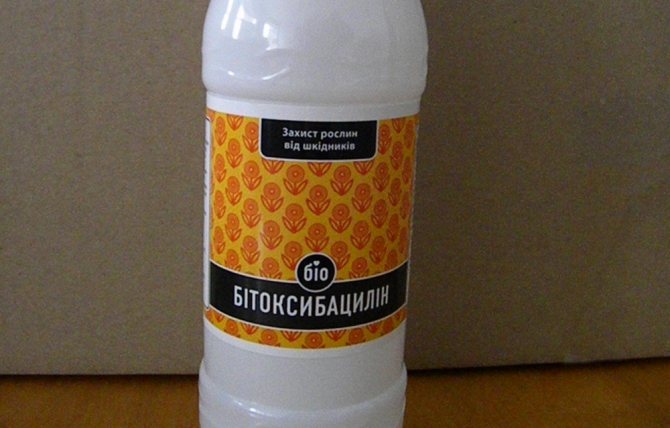

Mechanical methods
Mechanical methods of dealing with tracks include:
- collecting the affected parts of the plant with their subsequent burning;
- systematic digging of soil around the trunk;
- destruction of found nests with eggs, larvae.
You can manually collect pests. To do this, it is recommended to arm yourself with gloves and goggles, since the caterpillars actively react to danger and, at the slightest touch, can release a substance that causes an allergic reaction, inflammation, and redness on the skin.
Folk remedies
You can fight caterpillars using effective folk remedies:
- tie the barrel with masking tape treated with rodent glue; this will facilitate the adhesion and death of caterpillars that descend to turn into pupae;
- decompose the bait using fermenting agents that allow the destruction of caterpillars during the summer season;
- spray a pine tree using a water solution of liquid soap.
Folk remedies will save the pine from losing its beautiful appearance and subsequent death.
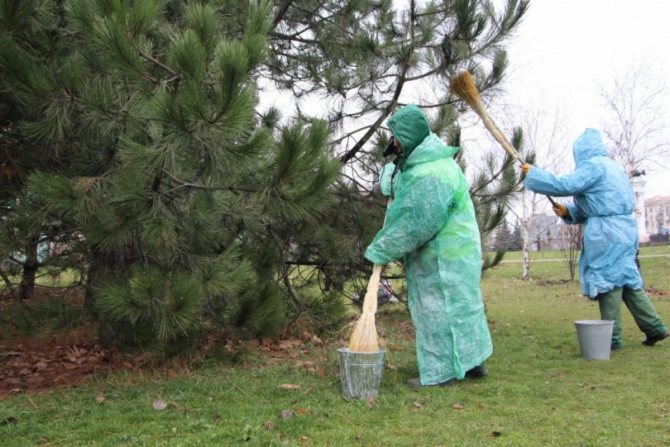

Gardeners reviews
“If on the site there is already a plant affected by stem pests, Siberian cedar pine, then we can expect that other pines will also be amazed by this pest, urgently treat all the pines, especially since you can already see the entrance holes on them. It is better to use systemic drugs such as Aktara and Confidor. You can drop actellic or fufanon from a syringe into all the holes you see. Stem pests lay eggs under the bark, the larvae hatch there and begin to devour a layer that is very important for the tree, which is located immediately under the bark, the vascular system of the tree passes through it, all the juices in the plant go up and down. The larvae interrupt the vessels. the branches cease to receive food, therefore the needles turn yellow. "
“This is Hermes (aphid of conifers). It is necessary to process twice, with an interval of 14-20 days, with Fufanon or Decis. In case of relapse (the plant must be looked after all season), repeat the treatment, alternating preparations. "
Types of caterpillars attacking trees
Various pests can settle on coniferous trees, which enter the territory of garden plots from the forest belt, through the soil or when buying seedlings of spruce, cedar or pine trees.
The most common ones are:
- pine moths - larvae that emerge from eggs laid by butterflies in the form of straight lines;
- common, oriental or red sawfly, whose larvae gnaw the branches of conifers, as can be seen in the photo of caterpillars on a pine;
- pine scoop - attacks trees in May, preferring to eat young buds and needles, which contributes to the subsequent drying of plants;
- black caterpillars - they braid the needles with cobwebs to keep them on the tree, then a mining moth appears from them;
- Siberian silkworm and pine cone moth, whose caterpillars eat seeds and cones on pines;
- the gypsy moth infects conifers only in the absence of other food for the caterpillars.
Hermes on fir and larch
The primary signs of the defeat of fir and larch by sherry are the withering of the beauty of the appearance. First of all, the crown thinns on the fir, the needles become red, sparse, dry and have an unkempt appearance. Trees begin to ache from the lower branches.
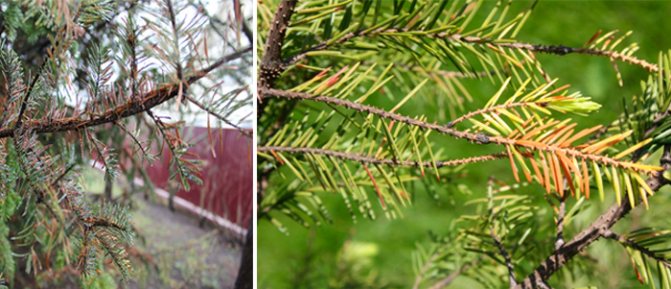

Also, upon close examination, you can notice an unhealthy brown bloom on the needles of fir and in old shoots, it is there that parasites first of all populate.
Unlike cedar, it is more difficult to notice symptoms of the disease on fir, since it is not covered with fluff, and yellowing of the branches can be caused by other infections. In this case, the choice of treatment must be very careful, since an error can only aggravate the situation.
As for larch, we can say that it gets sick less often. The needles on this breed are renewed annually, so pests settle on it less often. But it is also more difficult to detect them, since larch does not turn yellow, but remains green all summer. Despite this, if it grows next to other conifers, it must also be examined for the presence of insects, and in case of illness, treated along with other crops.
What does a pest larva look like?
There are several types of such insects:
Despite the external differences, insects inflict the same damage, since they have identical habits. The only difference is reproduction. The common sawfly produces at least two generations during the summer season, and can do more harm.
In all aboveground areas, parsley and carrots form whitish goose sponges, which gradually turn into dirty cakes. Later, very small, dark, spherical beetles appear on these surfaces. The attacked parts are fragile, gray-green in color, and grow poorly. The damage is greatest during the dry and hot summers. The attacking pot cannot be used for culinary purposes or for feeding.
Biological methods
Biological control methods include:
- Planting plants that are afraid of aphids around trees and shrubs. For example, celandine.
- Creation of suitable conditions for beneficial insects - ladybirds. They eat aphids. The family of these insects will destroy the colony in just two days.
- Birds eat aphids with pleasure. Hanging birdhouses and feeders is a reliable way to get rid of not only aphids, but also other pests.
Creating conditions that will not be suitable for parasites is biological protection against pests.
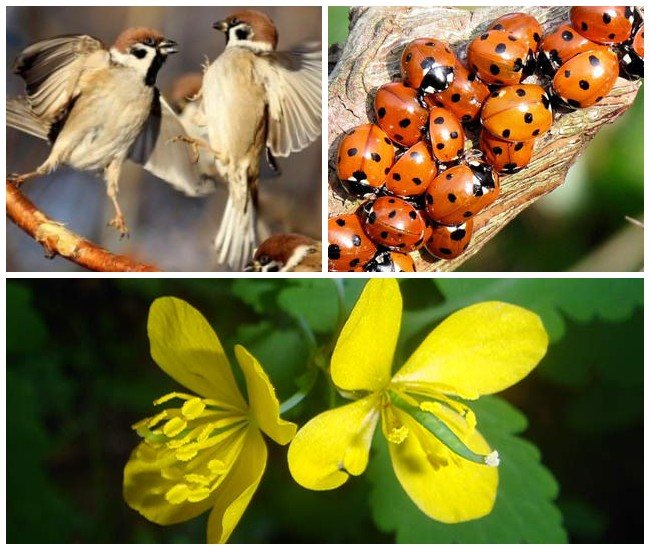

Additional tips and tricks
Coniferous trees need to be looked after differently than fruit trees. In order for the trees to please with their crown, pests do not settle on them, they need pruning, some of them in shelter for the winter.
- Conifers are not cut annually, but as needed. All branches that have dried up, have even a small amount of dry needles, are sick, need to be cut out.
- Young thujas under the age of 7 years are best covered with spunbond for the winter. Covers can be bought at the store, or you can make yourself.
- Thuja branches must be thinned out in the thick near the trunk, all dried up and diseased ones must be removed. Do the same with fir branches.
- It is better to spray conifers to protect against parasites in early spring, after pruning. Spill near-trunk circles after the soil has dried.
To prevent the appearance and get rid of aphids, it is necessary to regularly inspect the plants, carry out processing on time, spray newly imported seedlings, and prune diseased and damaged branches.


